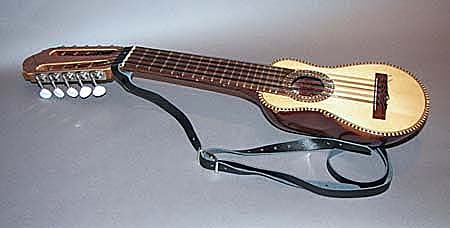
Owner: HWMC
Catalog#: LA-CHLT-02
Lutes
Bolivia ‘Charango’ (Gamboa)
Bolivia
Bolivian Campesinos (farmers)
Rosewood back and sides, Brazilian cedar neck, spruce top, mother-of-pearl inlay, metal strings
Early 20th century
Length: 27 in; Width 10 in; Depth: 1.75 in
Chordophones – Lutes
The charango is a small, fretted lute from the Andean regions of Bolivia, Peru, and Argentina. This armadillo-shaped charango is sometimes called kirkinchu (Quechua for ‘armadillo’) or kirki in Peru and Bolivia, and tatu or mulita in Argentina. There are two main modern types of charangoes, those with a flat back and those with the armadillo-shaped back. This armadillo-shaped charango with metal strings is played by the campesinos (farmers) in northern Argentina and the Lake Titicaca region of Peru and Bolivia. It is played only by men as a solo or ensemble instrument and is used predominantly for courting and festival dances.
This charango is made by Bolivian Luthier Juan Gamboa. It is a ten-string – 5-course lute, usually tuned in A minor (e”/e” – a’/a’ – c”/c” – g’/g’) and E minor (b’/b’ – e”/e” – b’/b’ – g”/g” – d”/d”). It has a wooden back in the shape of the Bolivian three-toed armadillo shell (now an endangered species). There are 17 metal frets and mechanized tuning pegs with acrylic grips/knobs. Both around the sound hole and the edges are an embellished decorative marquetry of intricate wood inlay.
Resource: “Charango,” Thomas Turino. “The Grove Dictionary of Musical Instruments.” 2nd ed., Vol. 1., Laurence Libin, Editor in Chief. Oxford University Press, 2014.
